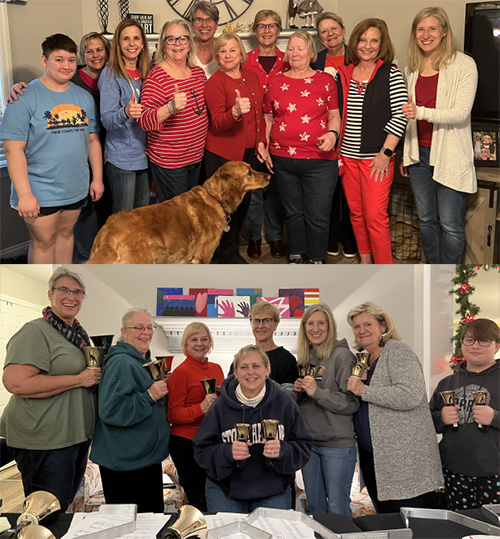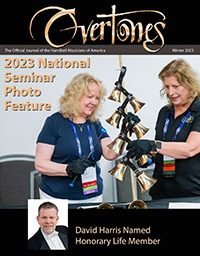A new program gets an ensemble of beginning ringers making music in a short time.
by Hillary Marotta

Hillary Marotta fell in love with playing handbells at Bucknell University under Dr. William Payn’s baton. She has continued to play for groups in Virginia and Pennsylvania, including substitute ringing and conducting at Bucknell. Hillary is a Virtuoso and Distinctly Bronze alum and serves on the National Seminar Planning Committee. She is the coordinator for both Distinctly Teen and College Ring-In. Hillary conducts her own beginning level handbell group and is the author of “Playing My Heart Out: One Ringer’s Passion for Handbells.”
That is the very thing that I have had the privilege to experience over the past nine months from the opposite side of the podium. Having always been an educator of some type, my giddy teacher side was beaming at the opportunity to start teaching handbells, from the very beginning point of what a bell is and how it works.
Several years ago, I was gifted a 3-octave set of used Schulmerich bells, and as the pandemic waned, I searched for something more to do with them than practice my own music. While they are fabulous for that purpose, I knew I wanted to share them with others. On a whim, not knowing if anything would come to fruition, I put together a paragraph about a Bell Basics class. At first, I thought I would target teens, but it became clear immediately that trying to fit an additional activity into teens’ already packed schedules might prove impossible. So, I turned to my friends (some of whom were the moms who would have had to transport those very teens), and shared my idea. To my great surprise, several of them were interested in learning handbells themselves. Since my graduate degree is in adult education, this was my wheelhouse. However, I wasn’t even ready to tell the social media community I was committing to this. After all, what if it failed miserably? What if no one actually showed or ever came back after the first meeting?

Members of Hillary Marotta’s first two six-week Back to Basics sessions.
As always, thank goodness for friends and other musicians. Last October, seven friends, ranging from someone who plays bells regularly and would support the group to several people who had never rung a bell before, converged in my home to take their first Bell Basics class. Having the bells at home gives me a unique advantage, which I think has been key to the program. Teaching these ringers in a home atmosphere felt a lot different to them than having to go to a public place to be vulnerable about a new skill. We sat in my family room, we rang in my living room, all while the dog meandered about and the kids occasionally interrupted. Now, will we get to a national stage with this practice strategy? No. However, my new ringers were comfortable, happy, and eager to learn without the pressure of stepping into an already-formed choir or in front of someone expecting them to catch up quickly.
We started from the very beginning, as the name implies, and they learned everything from the way the bell is made to its history and how it works. Everyone practiced ringing all the different bells in three octaves, and we covered whole notes through eighth notes, ringing and damping, different stopped sounds, and dynamics. We worked through drills for basic skills but immediately also began playing songs in order not only to demonstrate their immediate progress but also keep them interested. The fall six-week session conquered an arrangement of Pachelbel’s Canon in D and Jingle Bells as we approached Christmas. The spring session devoured a lovely arrangement of America the Beautiful, some wanting to debut it to the public! Since I had many returners during the spring session, we were able to add some additional new skills such as shaking, plucking, and malleting.
What made me smile most at the end of each class over the year is the pride and sense of accomplishment these ringers emoted. From learning to ring a bell to actually making music, these ringers were enthusiastic, excited, and amazed at what they could do. As a teacher, nothing in the world makes me feel more thrilled. As a musician teaching music consistently for the first time, it made my heart absurdly happy. I was taking something I had and giving it to them, and they found joy in it. There’s nothing more I could ask for than that, the heartwarming feelings of making music and connecting together as a community. If I can share even a portion of how handbells make me feel and convey that to others, my soul sings. When asked about their experiences in the group, one ringer said, “Ringing is a combination of following musical notes and lyrics, being able to bring different tones to the bells by how you play them, even if it’s the same note, and hearing the absolute beauty when it’s all put together that just makes your soul come alive!” Yes!
The music these ringers created together made me smile from ear to ear, but just as important to me was watching the deep connections being formed between them. As ringers, we are keenly aware of the sense of community we need to build to make great music. I was honored to be the quiet observer while these ringers found things in common, shared laughs, and built friendships. Laughter was a major component of each of our evenings together and kept the learning environment fun, inviting, and pressure-free. After all, how serious can you be when you get halfway through a song and one of your ringers yells out, “FF – play loud!”. It was a thrilling bonus for me that some of these ringers formed lasting friendships and look forward to coming together again as their own little handbell family.
The ringers took the summer off, but four of them volunteered to ring a quartet with piano accompaniment in church over the summer, and I am delighted. With this group, there was never an intent to perform publicly, which is also key to their enthusiasm and progress, but there are always personalities that like to give it a go, and I’m all for it for those who are comfortable. The majority of the ringers from the fall returned for the spring and again this fall. Comically, they now consider themselves the ‘advanced’ group and told me I might have to form a different group for newbies! No matter what happens, teaching Bell Basics has been a true musical highlight of my year, and if you’re interested in serving very beginning ringers simply to introduce them to a new passion or prepare them for something more, I may have just found the formula!
That is the very thing that I have had the privilege to experience over the past nine months from the opposite side of the podium. Having always been an educator of some type, my giddy teacher side was beaming at the opportunity to start teaching handbells, from the very beginning point of what a bell is and how it works.
Several years ago, I was gifted a 3-octave set of used Schulmerich bells, and as the pandemic waned, I searched for something more to do with them than practice my own music. While they are fabulous for that purpose, I knew I wanted to share them with others. On a whim, not knowing if anything would come to fruition, I put together a paragraph about a Bell Basics class. At first, I thought I would target teens, but it became clear immediately that trying to fit an additional activity into teens’ already packed schedules might prove impossible. So, I turned to my friends (some of whom were the moms who would have had to transport those very teens), and shared my idea. To my great surprise, several of them were interested in learning handbells themselves. Since my graduate degree is in adult education, this was my wheelhouse. However, I wasn’t even ready to tell the social media community I was committing to this. After all, what if it failed miserably? What if no one actually showed or ever came back after the first meeting?

Members of Hillary Marotta’s first two six-week Back to Basics sessions.
As always, thank goodness for friends and other musicians. Last October, seven friends, ranging from someone who plays bells regularly and would support the group to several people who had never rung a bell before, converged in my home to take their first Bell Basics class. Having the bells at home gives me a unique advantage, which I think has been key to the program. Teaching these ringers in a home atmosphere felt a lot different to them than having to go to a public place to be vulnerable about a new skill. We sat in my family room, we rang in my living room, all while the dog meandered about and the kids occasionally interrupted. Now, will we get to a national stage with this practice strategy? No. However, my new ringers were comfortable, happy, and eager to learn without the pressure of stepping into an already-formed choir or in front of someone expecting them to catch up quickly.
We started from the very beginning, as the name implies, and they learned everything from the way the bell is made to its history and how it works. Everyone practiced ringing all the different bells in three octaves, and we covered whole notes through eighth notes, ringing and damping, different stopped sounds, and dynamics. We worked through drills for basic skills but immediately also began playing songs in order not only to demonstrate their immediate progress but also keep them interested. The fall six-week session conquered an arrangement of Pachelbel’s Canon in D and Jingle Bells as we approached Christmas. The spring session devoured a lovely arrangement of America the Beautiful, some wanting to debut it to the public! Since I had many returners during the spring session, we were able to add some additional new skills such as shaking, plucking, and malleting.
What made me smile most at the end of each class over the year is the pride and sense of accomplishment these ringers emoted. From learning to ring a bell to actually making music, these ringers were enthusiastic, excited, and amazed at what they could do. As a teacher, nothing in the world makes me feel more thrilled. As a musician teaching music consistently for the first time, it made my heart absurdly happy. I was taking something I had and giving it to them, and they found joy in it. There’s nothing more I could ask for than that, the heartwarming feelings of making music and connecting together as a community. If I can share even a portion of how handbells make me feel and convey that to others, my soul sings. When asked about their experiences in the group, one ringer said, “Ringing is a combination of following musical notes and lyrics, being able to bring different tones to the bells by how you play them, even if it’s the same note, and hearing the absolute beauty when it’s all put together that just makes your soul come alive!” Yes!
The music these ringers created together made me smile from ear to ear, but just as important to me was watching the deep connections being formed between them. As ringers, we are keenly aware of the sense of community we need to build to make great music. I was honored to be the quiet observer while these ringers found things in common, shared laughs, and built friendships. Laughter was a major component of each of our evenings together and kept the learning environment fun, inviting, and pressure-free. After all, how serious can you be when you get halfway through a song and one of your ringers yells out, “FF – play loud!”. It was a thrilling bonus for me that some of these ringers formed lasting friendships and look forward to coming together again as their own little handbell family.
The ringers took the summer off, but four of them volunteered to ring a quartet with piano accompaniment in church over the summer, and I am delighted. With this group, there was never an intent to perform publicly, which is also key to their enthusiasm and progress, but there are always personalities that like to give it a go, and I’m all for it for those who are comfortable. The majority of the ringers from the fall returned for the spring and again this fall. Comically, they now consider themselves the ‘advanced’ group and told me I might have to form a different group for newbies! No matter what happens, teaching Bell Basics has been a true musical highlight of my year, and if you’re interested in serving very beginning ringers simply to introduce them to a new passion or prepare them for something more, I may have just found the formula!

Hillary Marotta fell in love with playing handbells at Bucknell University under Dr. William Payn’s baton. She has continued to play for groups in Virginia and Pennsylvania, including substitute ringing and conducting at Bucknell. Hillary is a Virtuoso and Distinctly Bronze alum and serves on the National Seminar Planning Committee. She is the coordinator for both Distinctly Teen and College Ring-In. Hillary conducts her own beginning level handbell group and is the author of “Playing My Heart Out: One Ringer’s Passion for Handbells.”

